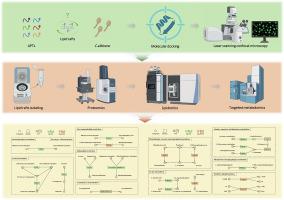抗真菌肽APTs通过与脂筏相互作用对白色念珠菌发挥抑菌作用
IF 8
1区 农林科学
Q1 FOOD SCIENCE & TECHNOLOGY
引用次数: 0
摘要
从乳酸菌中提取的抗菌肽因其抗菌特性而受到关注,但其抗真菌机制仍未得到充分探讨。本研究从副干酪乳杆菌ALAC-4中分离的抗真菌肽APTs,通过与脂筏相互作用作为潜在的介质,研究其对白色念珠菌的抑菌机制。分子对接发现,APTs与羊毛甾醇14α-去甲基化酶(RMSF 0.99 Å)之间存在稳定的相互作用。激光扫描共聚焦显微镜显示,在白色念珠菌膜中,APTs与麦角甾醇共定位(Pearson’s r = 0.79)。蛋白质组学分析发现了显著的代谢紊乱,包括参与能量和磷酸盐代谢的关键酶的下调,以及氨基酸和碳水化合物代谢的改变。脂质代谢表现出明显的破坏,如甘油-3-磷酸脱氢酶和丝氨酸棕榈酰转移酶的上调。此外,应激反应蛋白和ABC转运蛋白通路均受到抑制。这些发现表明,APTs通过与脂筏相互作用和破坏多种代谢途径(包括能量、磷酸盐、氨基酸、碳水化合物和脂质代谢)来发挥抗真菌活性。本文章由计算机程序翻译,如有差异,请以英文原文为准。

Antifungal peptide APTs exerts its fungistatic effect against Candida albicans through interaction with lipid rafts
Antimicrobial peptides derived from lactic acid bacteria have gained attention for their antibacterial properties, yet their antifungal mechanisms remain underexplored. This research investigated the fungistatic mechanism of antifungal peptide APTs, isolated from Lacticaseibacillus paracasei ALAC-4, against Candida albicans, through interaction with lipid rafts as the potential mediator. Molecular docking revealed stable interactions between APTs and lanosterol 14α-demethylase (RMSF 0.99 Å). Laser scanning confocal microscopy revealed that APTs colocalized with ergosterol in the C. albicans membrane (Pearson's r 0.79). Proteomic analysis identified significant metabolic disruptions, including the downregulation of key enzymes involved in energy and phosphate metabolism, as well as alterations in amino acid and carbohydrate metabolism. Lipid metabolism exhibited marked disruption, as demonstrated by the upregulation of glycerol-3-phosphate dehydrogenase and serine palmitoyl transferase. Furthermore, suppression was observed in both stress response proteins and the ABC transporter pathway. These findings indicate that APTs exerts antifungal activity against C. albicans by interacting with lipid rafts and disrupting multiple metabolic pathways, including energy, phosphate, amino acid, carbohydrate, and lipid metabolism.
求助全文
通过发布文献求助,成功后即可免费获取论文全文。
去求助
来源期刊

Food Research International
工程技术-食品科技
CiteScore
12.50
自引率
7.40%
发文量
1183
审稿时长
79 days
期刊介绍:
Food Research International serves as a rapid dissemination platform for significant and impactful research in food science, technology, engineering, and nutrition. The journal focuses on publishing novel, high-quality, and high-impact review papers, original research papers, and letters to the editors across various disciplines in the science and technology of food. Additionally, it follows a policy of publishing special issues on topical and emergent subjects in food research or related areas. Selected, peer-reviewed papers from scientific meetings, workshops, and conferences on the science, technology, and engineering of foods are also featured in special issues.
 求助内容:
求助内容: 应助结果提醒方式:
应助结果提醒方式:


